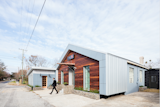EmmeDue Architecture Design Studio
Architect Transforms a Neighborhood Eyesore into his Impressive Design Studio
Charleston Auto Restoration Shop in ruins reconstructed into a modern industrial architectural office space conceived to inspire creativity and foster teamwork.
When my architect husband, Matteo Rapallini, AIA, and I, his business partner and design enthusiast set out to look for office space we never thought that we would end up buying a vestige, designing and rebuilding it from the ground up, and revitalizing the community in the process. But that’s exactly what happened.
Our office is 3,200 square feet and it used to be Pete’s Body Shop which was not just a car shop but a community hang-out spot since the 60’s in Maryville, a historically predominantly African American neighborhood here in Charleston. The fact that this spot was once an automotive-restoration shop was important to Matteo, who used to be a body shop mechanic before going back to school to become an architect. He decided to incorporate his auto body shop background into the design of the building and its details, thereby honoring their mutual roots.
I leave the rest of the project to be described in the Architect’s own words. He is in the habit of naming his projects, and he decided to name our office “The Roadster”.
THE ROADSTER
“Appearances are a glimpse of the unseen”
As you approach anything or meet anyone for the first time, first appearances are always important.
One day after visiting a dilapidated space, which was soon to be our future office, we sat over lunch discussing how incredibly unique our future office space would be. While waiting for our food I kept talking a doodling, doodling and talking, about all of ideas and vision which would make this building someday soon, what someone would call later "an object with incredible curb appeal". Exactly what I meant I thought. As I sketched, I imagined the space which for many years had been an automotive restoration shop; as I drew I thought: "I want it this building to have the same character of a Hot Rod, I want it to resemble a great classic. I want its facade to be timeless and distinct, with personality, with many layers; its elevation will resemble and express the strength of a great automobile. Imagine a 1938 Buick Special Coupe. We will craft the materials and restore it, we will make a Hot Rod of this historic American classic."
The facade of this building presented us with several major issues. There were originally two buildings — the old schoolhouse building of the 1800's was later tied to a 1950's grocery shop. How do you make two volumes like these coexist?
After many years, the two elements were part of each other, they belonged together; it made sense to the community and to the historical context of the neighborhood.
As I contemplated this dilemma, I concluded that the materials would help us achieve this synchronization. I brainstormed that a rain-screen system should be employed and that we ought to layer the materials like a Hot Rod: Its fenders and hood would be centrally framed by a grille — i.e. the cement fiberboard knuckle which encases the wood.
Its headlights would be depicted by the two tall donated Brombal units which at nighttime turn on as we leave the space to head home. I wanted part of that philosophy to reach over and embrace the adjacent space — the cement fiber board departs to one side (the building was not symmetrical after all), and reaches over to embrace the added volume. At this time they still looked different, they were two individual volumes with different characters. However, I conceived that the portion of the rain screen layer which departs from the main volume and reaches over brought the two elements together. I fantasized a motorcycle with a sidecar as the harmonizing concept.
2 more saves



















